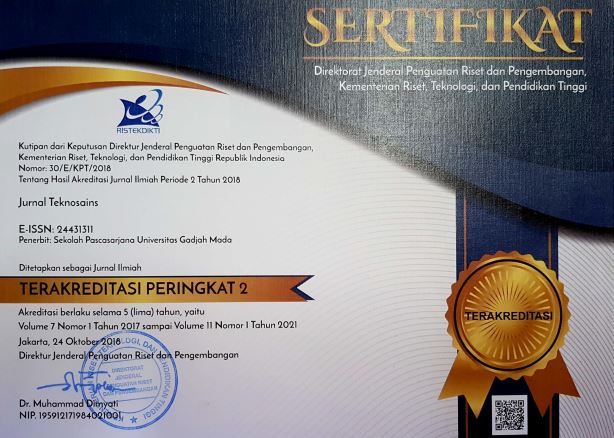MASTER RECESSION CURVE VISUALIZATION USING SEVEN BASEFLOW RECESSION MODELS IN PAIRED WATERSHEDS
Bokiraiya Latuamury(1*), Gun Mardiatmoko(2), Agustinus Kastanya(3)
(1) Department of Forestry, Pattimura University, Ambon-Maluku, Indonesia
(2) Department of Forestry, Pattimura University, Ambon-Maluku, Indonesia
(3) Department of Forestry, Pattimura University, Ambon-Maluku, Indonesia
(*) Corresponding Author
Abstract
Keywords
Full Text:
PDFReferences
Adji, T. N., Haryono, E., Fatchurohman, H., & Oktama, R. (2017). Spatial and temporal hydrochemistry variations of karst water in Gunung Sewu, Java, Indonesia. Environmental Earth Sciences, 76(20). https://doi.org/10.1007/s12665-017-7057-z
Aksoy, H., & Wittenberg, H. (2011). Analyse non linéaire des récessions de l’écoulement de base dans des bassins versants à écoulements intermittents. Hydrological Sciences Journal, 56(2), 226–237. https://doi.org/10.1080/02626667.2011.553614
Aksoy, H., & Wittenberg, H. (2015). Baseflow Recession Analysis for Flood-Prone Black Sea Watersheds in Turkey. Clean - Soil, Air, Water, 43(6), 857–866. https://doi.org/10.1002/clen.201400199
Arciniega-Esparza, S., Breña-Naranjo, J. A., Pedrozo-Acuña, A., & Appendini, C. M. (2017). HYDRORECESSION: A Matlab toolbox for streamflow recession analysis. Computers and Geosciences. https://doi.org/10.1016/j.cageo.2016.10.005
Bartlett, M. S., & Porporato, A. (2018). A Class of Exact Solutions of the Boussinesq Equation for Horizontal and Sloping Aquifers. Water Resources Research, 54(2), 767–778. https://doi.org/10.1002/2017WR022056
Basha, H. A. (2020). Flow Recession Equations for Karst Systems. Water Resources Research, 56(7), 1–21. https://doi.org/10.1029/2020WR027384
Botter, G., Porporato, A., Rodriguez-Iturbe, I., & Rinaldo, A. (2009). Nonlinear storage-discharge relations and catchment streamflow regimes. Water Resources Research, 45(10), 1–16. https://doi.org/10.1029/2008WR007658
Boughton, W. (2015). Master recession analysis of transmission loss in some Australian streams. Australian Journal of Water Resources, 19(1), 43–51. https://doi.org/10.7158/13241583.2015.11465455
Boussinesq, J. (1877). Essai sur la theories des eaux courantes. Memoires presentes par divers savants a l’Academic des Sciences de l’Institut National de France, Tome. In 1877 (XXIII).
Boussinesq, Joseph. (1877). boussinesq1877essai : Essai sur la theorie des eaux courantes. Impr. nationale.
Carlotto, T., & Chaffe, P. L. B. (2019). Computers and Geosciences Master Recession Curve Parameterization Tool ( MRCPtool ): Different approaches to recession curve analysis. Computers and Geosciences, 132(February), 1–8. https://doi.org/10.1016/j.cageo.2019.06.016
Dewandel, B., Lachassagne, P., & Krishnamurthy, N. S. (2006). A generalized 3-D geological and hydrogeological conceptual model of granite aquifers controlled by single or multiphase weathering. 260–284. https://doi.org/10.1016/j.jhydrol.2006.03.026
Endres, A. L., Jones, J. P., & Bertrand, E. A. (2007). Pumping-induced vadose zone drainage and storage in an unconfined aquifer: A comparison of analytical model predictions and field measurements. Journal of Hydrology, 335(1–2), 207–218. https://doi.org/10.1016/j.jhydrol.2006.07.018
Fatchurohman, H., Adji, T. N., Haryono, E., & Wijayanti, P. (2018). Baseflow index assessment and master recession curve analysis for karst water management in Kakap Spring, Gunung Sewu. IOP Conference Series: Earth and Environmental Science, 148(1). https://doi.org/10.1088/1755-1315/148/1/012029
Gregor, M. and Malík, P. (2012). User manual for Recession Curve 4.0. Version 2, 1–8.
Griffiths, G., & Clausen, B. (1997). Streamflow recession in basins with multiple water storages. Journal of Hydrology, 190(1), 60–74.
Hammond, M., & Han, D. (2006). Recession curve estimation for storm event separations. Journal of Hydrology, 330(3–4), 573–585. https://doi.org/10.1016/j.jhydrol.2006.04.027
Horton, R. (1933). The role of infiltration in the hydrological cycle. Trans. Am. Geophys. Union, 14, 446–460.
Kovács, A. (2003). Geometry and hydraulic parameters of karst aquifers – A hydrodynamic modelling approach. In PhD. thesis (p. 131). La Faculté des sciences de ľUniversité de Neuchâtel, Suisse.
Kullman, E. (1990). Krasovo-puklinové vody. Karst-fissure waters. In GÚDŠ, Bratislava, [in Slovak with Slovak Extended Sumarry] (p. 184).
Latuamury, B., Marasabessy, H., Talaohu, M., & Imlabla, W. (2021). Small island watershed morphometric and hydrological characteristics in Ambon Region, Maluku Province. IOP Conference Series: Earth and Environmental Science, 800(1). https://doi.org/10.1088/1755-1315/800/1/012047
Latuamury, B. O. (2018). Analisis Kurva Resesi Aliran Dasar Menggunakan Model Reservoir Linier Recession Curve Hydrooffice Pada Das Wuryantoro Kabupaten Wonogiri Propinsi Jawa Tengah. Jurnal Teknosains, 7(1), 26. https://doi.org/10.22146/teknosains.32395
Latuamury, B., Parera, L. R., & Marasabessy, H. (2020). Characterizing river baseflow recession using linear reservoir model in Alang Watershed, Central Java, Indonesia. Indonesian Journal of Geography, 52(1). https://doi.org/10.22146/ijg.43565
Latuamury, Bokiraiya, Imlabla, W., Sahusilawane, J., & Marasabessy, H. (2022). Comparing Master Recession Curve Shapes Between Linear and Exponential Reservoir Models. Journal of Geographical Studies, 6(2), 68–72. https://doi.org/10.21523/gcj5.22060202
Latuamury, Bokiraiya, Osok, R. M., Puturuhu, F., & Imlabla, W. N. (2022). Baseflow separation using graphic method of recursive digital filter on Wae Batu Gajah Watershed, Ambon City, Maluku. IOP Conference Series: Earth and Environmental Science, 989(1), 012028. https://doi.org/10.1088/1755-1315/989/1/012028
Lee, G., Shin, Y., & Jung, Y. (2014). Development of web-based RECESS model for estimating baseflow using SWAT. Sustainability (Switzerland), 6(4), 2357–2378. https://doi.org/10.3390/su6042357
Maillet, E. (1905). Essais d’Hydraulique Souterraine et Fluviale. In Hermann Paris (p. 218).
Nurkholis, A., Adji, T. N., Haryono, E., Cahyadi, A., Waskito, W. A., Fathoni, H., Kurniawan, I. A., & Agniy, R. F. (2019). Analysis of Master Recession Curve (MRC) and flood hydrograph components for karstification degree estimation in Kiskendo Cave, Jonggrangan Karst System, Indonesia. IOP Conference Series: Earth and Environmental Science, 256(1). https://doi.org/10.1088/1755-1315/256/1/012011
Rupp, D. E., & Selker, J. S. (2006). On the use of the Boussinesq equation for interpreting recession hydrographs from sloping aquifers. Water Resources Research, 42(12), 1–15. https://doi.org/10.1029/2006WR005080
Şener, A., Yolcubal, İ., & Sanğu, E. (2020). Determination of recharge, storage and flow characteristics of a karst aquifer using multi-method approaches (Kocaeli, Turkey). Hydrogeology Journal, 28(6), 2141–2157. https://doi.org/10.1007/s10040-020-02183-1
Stoelzle, M., Stahl, K., & Weiler, M. (2013). Are streamflow recession characteristics really characteristic? Hydrology and Earth System Sciences. https://doi.org/10.5194/hess-17-817-2013
Sujono, J., Shikasho, S., & Hiramatsu, K. (2004). A comparison of techniques for hydrograph recession analysis. Hydrological Processes, 18(3), 403–413. https://doi.org/10.1002/hyp.1247
Tashie, A., Pavelsky, T., & Band, L. E. (2020). An Empirical Reevaluation of Streamflow Recession Analysis at the Continental Scale. Water Resources Research, 56(1), 1–18. https://doi.org/10.1029/2019WR025448
Tashie, A., Pavelsky, T., & Emanuel, R. E. (2020). Spatial and Temporal Patterns in Baseflow Recession in the Continental United States. Water Resources Research, 56(3), 1–18. https://doi.org/10.1029/2019WR026425
Article Metrics
Refbacks
- There are currently no refbacks.
Copyright (c) 2024 Bokiraiya Latuamury et al.

This work is licensed under a Creative Commons Attribution-ShareAlike 4.0 International License.
Copyright © 2024 Jurnal Teknosains Submit an Article Tracking Your Submission
Editorial Policies Publishing System Copyright Notice Site Map Journal History Visitor Statistics Abstracting & Indexing










